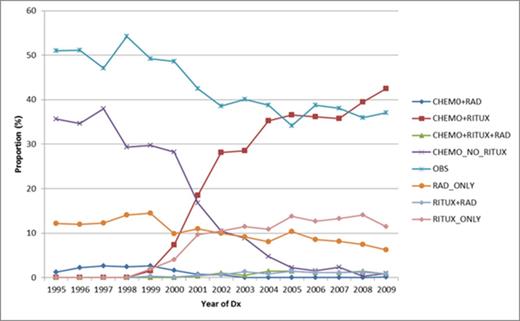Abstract
The treatment paradigm for FL has evolved greatly since the advent of rituximab (R) in 1997. However, a standard of care for first-line management of FL is yet to emerge (Friedberg, JCO 2009). This study seeks to describe the determinants of and temporal patterns in the use of first-line management strategies.
We used the linked Surveillance, Epidemiology, and End Results (SEER)-Medicare database to identify 7,931 FL patients (pts) aged ≥ 66 years diagnosed between 1995 and 2009. We ascertained first-line management strategies from Medicare claims made within 90 days of diagnosis. Pts with no FL related treatment claims were classified as observation (obs). We used multiple variable logistic regression models to evaluate the relationship between pt characteristics and the use of two common first-line management strategies—obs and immunochemotherapy with R, cyclophosphamide, doxorubicin, vincristine, and prednisone (R-CHOP).
Of the 7,931 pts, 57% were female, 3% were African American, 93% were White, 51% resided in big metropolitan areas, 52% were diagnosed after the year 2000, 44% had stage III/IV disease, 17% had grade 3 disease, and 39% had extranodal involvement. The median age at diagnosis was 75 years (interquartile range 70-80). Common first-line management strategies were: obs, 41%; chemotherapy (chemo) plus R, 26%; chemo alone, 11%; R alone, 10%; and radiotherapy (rad) alone, 9%. Among pts receiving chemo plus R the most commonly used regimens were: R-CHOP (50%), R-CVP (R, cyclophosphamide, vincristine, and prednisone, 35%), R-Fludarabine based (7%), R-Other (7%). Trends in the use of first-line management strategies are displayed in the figure. Obs was more commonly associated with age ≥81 years (ref. age 66-70 years; OR 1.41; 95% CI 1.22-1.62) and African American race (ref. White race; OR 1.77; 95% CI 1.33-2.37), and less commonly associated with stage III/IV FL (ref. stage I/II FL; OR 0.84; 95% CI 0.76-0.93); grade 3 FL (ref. grade 1/2 FL; OR 0.37; 95% CI 0.32-0.43), presence of B symptoms (ref. absent; OR 0.54; 95% CI 0.41-0.71), and year of diagnosis (ref. year 1995; OR for 2002 0.57; 95% CI 0.35-0.94; steady decrease thereafter). In the cohort of patients diagnosed between 1999 and 2000, first-line R-CHOP was more commonly associated with stage III/IV FL (ref. stage I/II; OR 1.53; 95% CI 1.27-1.83), grade 3 FL (ref. grade 1/2; OR 7.30; 95% CI 5.86-9.09), presence of B symptoms (ref. absent; OR 1.46; 95% CI 1.04-2.04), and year of diagnosis (ref. years 1999-2001; OR for 2002 3.74; 95% CI 2.38-5.87; steady increase thereafter), and less commonly associated with age 76-80 years (ref. age 66-70 years; OR 0.65; 95% CI 0.51-0.82), age ≥81 years (OR 0.20; 95% CI 0.15-0.27), African American race (ref. White race; OR 0.46; 95% CI 0.25-0.85) and comorbidity index ≥2 (ref. index 0; OR 0.55; 95% CI 0.41-0.76).
As anticipated, the use of chemo plus R and single-agent R increased steadily after the introduction of R in1997, while that of obs and chemo alone decreased over the same period.
No relevant conflicts of interest to declare.
Author notes
Asterisk with author names denotes non-ASH members.


